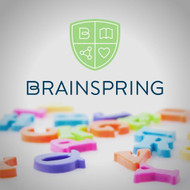The Importance of Correct Letter Formation
Posted by Brainspring on 28th Feb 2023
 In Brainspring classes, instructors often mention the “science” behind letter formation. What is that “science” and why is it important to our students’ writing? How can we help our students with correct letter formation? A simplified answer is to teach correct letter formation and then practice, practice, practice.
In Brainspring classes, instructors often mention the “science” behind letter formation. What is that “science” and why is it important to our students’ writing? How can we help our students with correct letter formation? A simplified answer is to teach correct letter formation and then practice, practice, practice.
Letter formation is the ability to write the letters of the alphabet correctly conforming to a cultural standard. This process includes pencil placement when starting and moving the pencil in the right direction. The letters must also be placed in the appropriate spots on the lines. Correct letter formation allows and encourages students to write efficiently with less fatigue and with less errors. When using lower case, forming the b and d correctly (with the correct initial strokes) leads to far less confusions in writing.
There are several activities to encourage and practice correct letter formation. Brainspring’s mantra: top to bottom, left to right, works with most letters, and serves as a reminder of how we read and how we write. (The Phonics First© Kindergarten Lesson plan includes letter formation steps before Dictation.)
Young students may need to practice correct pencil grip. Give students two containers, one of them filled with small objects (pennies, beads, etc.). Ask student to grasp a small pom-pom or rolled up ball of tissue paper in the last two fingers of their writing hand. Using their other three fingers (pincher grip), student transfer the objects one at a time from one container to the next. This pincher grip is very useful when their pencils begin writing letters. Once students begin actual writing, give them many opportunities to practice top-to-bottom and left-to-right lines. The “c” stroke is used in several lower-case letters and should be formed correctly (beginning at the top).
Add glue dots and starting points and arrows to your card pack. During the Visual Drill in small group instruction, ask students to trace difficult letters and any errors by placing the card in front of the student.
The Auditory Drill is where correct letter formation should be practiced. Insist on correct strokes and encourage students to practice difficult letters several times in the sand tray. Incorporating the tactile sense increases their retention. Also, in small group instruction, watch your students’ letter formation during Dictation. Keep a sand tray available to practice difficult letters or ask students to “trace and erase” letters written on the dry-erase boards (after students write the letters with their markers, they erase the letter with their finger). Remember, always quality over quantity.
Written by Ingrid Hartig
Ingrid is an Education Consultant with Brainspring.

Brainspring has proudly supported the educational community for more than 25 years.
Our Educator Academy provides educators in grades K-12 with comprehensive MSL Professional Development courses. Learn more about our courses here or reach out to our Partnerships Team.
The Learning Centers support students through one-on-one, multisensory tutoring sessions. Learn more about our in-person (available in Southeast Michigan) and Nationwide Online Tutoring.
